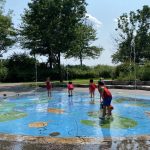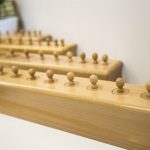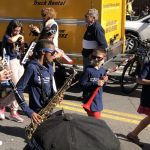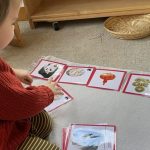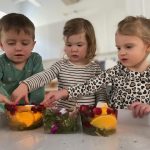Primary Program
The Primary Program is specifically designed to support your child’s natural drive for independence by encouraging choice of activities of interest without interruption. This program encourages children to find joy in work and learning as a foundation for mastering essential lifelong skills, habits and attitudes — both academic and practical. Developmentally, children this age have an intense desire for physical independence and thrive on opportunities to assert it.
The classrooms are specially designed for the children who use them — chairs, tables, and shelves are sized proportionately, allowing students the freedom to explore the environment. The classrooms also feature tactile and visually appealing materials that naturally engage children in learning, cultivating internal motivation and positive self-esteem. Each Primary classroom operates as a community, helping children learn the art of living in a world beyond home. The continuity of the three-year cycle allows students to experience different roles, responsibilities and perspectives.
Primary Program Scheduling Options
Full Day Program Hours: approximately 8:30am – 3:00pm
Half Day Program Hours: approximately 8:30am – 11:45pm
After-School Care: 3:00 – 5:30pm
School Year: August* – June
*At the beginning of the school year, Primary students are phased in over the first week of school.
Additional Summer Programs and After-School Programs are available for enrolled families.
The Primary program day is designed to cultivate independence in our 3- to 6-year-old students, as well as to foster their role as members of a community. The morning includes an uninterrupted work cycle — a fundamental aspect of Montessori education — which allows students the freedom to move about the prepared classroom environments, to interact with peers and to discover and choose work that interests them. Teachers spend this time carefully observing students, assessing their needs and gauging their readiness for new lessons and materials. There is time for individual or small-group lessons as well as time for class discussions and community meetings, creating an atmosphere of mutual respect and cooperation.
Individualized Curriculum
Your child will be introduced to activities and concepts based upon the trained Montessori teacher’s observations of their developmental needs and readiness. After an initial lesson, the child can come back to the material for independent exploration. It is the job of the Montessori teacher to find the activity that combines both interest and the right challenge—not too hard and not too easy. This is when the child becomes engaged, developing an increased ability to focus and concentrate.
Independence
The child is carefully taught how to care for his or her own needs and provide opportunities to practice and improve. From preparing a meal to solving a complex math problem, children are given the opportunity to complete work on their own. When children can successfully care for themselves and the environment in which they live, their sense of accomplishment and confidence increases. As this independence is fostered, we hear the children begin to say, “I can do it on my own.”
Hands-on Learning Materials
Scientifically designed Montessori materials are made to bridge the gap between tangible and abstract concepts, with built-in fail-safe to allow for independent learning and self-correction. Some of the materials in our Primary Program are for:
- Language – Materials to enrich vocabulary and open the door to writing, reading, and the parts of speech.
- Mathematics – Materials build on your child’s natural interest in counting and introduce an understanding of the decimal system and the processes of addition, subtraction, multiplication, and division in the 3-6 classroom.
- Art and Self-expression – Montessori materials also encourage artistic self-expression in the classroom.
- Geography – Globes, flags of the world, and maps are introduced in Children’s House, giving students a greater understanding of the world and cultures around them.
- Science – Children explore botany, zoology, astronomy, and more through rich hands-on experience in the classroom and the Outdoor Environments.
Throughout the classroom, there is a huge variety of materials to choose from – each one with a thoughtful lesson behind it.
Mixed-age Classrooms
Because the learning is individualized, your child can work at his or her own pace while participating in a mixed-age classroom community. Younger children benefit from example, and learn from the activities of the older children, while each older child gains the self-confidence that comes with responsibility and leadership.
Grace and Courtesy
Through grace and courtesy exercises, we teach children how to appropriately work through conflicts, how to act politely in various situations, and how to be kind and helpful to others. The result is a cohesive and self-aware community of young children.
Primary Curriculum
Throughout the classroom, students explore specially designed Montessori materials that are multi-sensory, hands-on, concrete and self-correcting.
There is dynamic interaction among the various curriculum areas of the Montessori classroom. The specific skills of each area build upon each other and are interrelated to and dependent on skills learned in other areas of the classroom. This connection enhances children’s natural interest in and enthusiasm for learning.
Each child progresses at his or her own individually appropriate pace, allowing each to be appropriately challenged and to become proficient in each area according to individual development and needs.
Practical Life activities are central to the Montessori classroom and prepare the child for all other areas. Practical Life exercises give children the opportunity to refine their fine motor skills, hand-eye coordination, hand strength, balance, concentration and ability to do things for themselves. Through the repetition of Practical Life activities, children develop practical skills that will serve them all their lives. Some of the Primary Practical Life exercises include Pouring, Lacing, Scooping, Flower Arranging, Food Preparation and Serving, and Table Washing.
Sensorial materials are designed to help children learn about qualities like color, size, shape, length, texture, and sound. 3-6 year olds are increasingly able to make finer and finer discriminations of the many stimuli all around them. Sensorial activities assist children in refining this skill and becoming good observers of the world. Montessori saw the importance of the manipulation of objects to aid the child in better understanding their environment. Through the child’s work with Sensorial material, the child is helped to make abstractions, they are helped in making distinctions in their environment, and the child is given the knowledge not through word of mouth, but through their own experiences. Sensorial materials in the Primary classroom include Knobbed Cylinders for practice with dimension, Color Tablets, Rough and Smooth Boards, Geometric Solids, the Pink Tower, and the Binomial Cube.
Language pervades the Montessori classroom and crosses all curriculum areas. Primary students discover the awesome power of writing through the use of sandpaper letters, the metal insets, and the movable alphabet. Simultaneously, they experience the ability to associate sounds with symbols and discover the mechanical ability to translate that knowledge into writing. The ability to write opens the door to reading. Children expand their ability to communicate by increased auditory discrimination, developing an enormous vocabulary, critical thinking, and fluency. They are exposed to concepts of print, develop a reading and writing protocol, and build a relationship with narrative literature. The simultaneity of writing and reading leads to participation in group discussions, reflection, sharing, drawing, singing, poetry, storytelling, read-alouds, dramatic play, and creative movement.
Classrooms are filled with stimulating Montessori mathematics materials designed to promote primary student growth in understanding mathematical concepts. Children develop numeracy and numeral recognition using sandpaper numerals and teens and ten boards and become confident in manipulating numbers and representing various quantities with numerals. They explore the operations of arithmetic through the unique Montessori Golden Beads materials.
Kindergartners take full advantage of drawings, graphs, maps, charts, and numerals to record their understanding of mathematical concepts. Measurement exploration including comparison, estimation, time, fractions, and money is introduced concretely and sensorially, leading to translating operational concepts into number sentences and equations. Performing operations of arithmetic with the Golden Beads leads to strong establishment of place value and the memorization concepts. The Bead Cabinet, which includes long and short chains with beads, provides concrete, multi-sensory experiences of the squaring and cubing of numbers from one to ten, at once reinforcing the memorization of multiplication, addition, subtraction and division.
Children are introduced to concrete lessons and activities in earth, life, and physical sciences. The child develops an introductory understanding of living and nonliving things, how they differ, and how to categorize plants and animals. Students care for plants in the classroom. They water the plants and spray and clean the leaves with water. The children may have a small plot of land to plant seeds, weed, water, feed, and harvest the crop.The children learn the nomenclature for parts of a plant—a leaf, a flower and a root. Students observe and participate in science experiments related to the needs of the plant. Also, by having a pet in the classroom, children are exposed to the traits, habits and food needs of the animal and are responsible for its care. Children attend field trips and horticultural visits and go on outings to enhance their experiences with plants and animals. Teachers and guest presenters present science lessons on topics such as parts of the earth, water and weather systems and rocks and crystals.
Building on their early experiences, children sort and classify the contents of their world and construct the knowledge of how all things are interconnected. Geography is an important part of the Montessori curriculum. The curriculum begins with the two hemispheres of Earth and becomes more and more detailed as children learn about continents, and then countries. The very young child will use the wooden puzzle maps as puzzles, but the older child can use the pieces as a guide as they make their own maps, labeled with their own handwriting when he is ready. They build personal timelines, which foster discussions of past, present, and future as a prelude to the study of history. In geography, the children are introduced to other cultures and discover what they have in common with all people.
In the Montessori classroom, children and adults take care to be gracious toward and courteous of one another. This area of the curriculum encourages respect for oneself, for other members of the community, for the living things in the classroom, and for the environment. Carrying things carefully, returning them to their place so others may use them, moving gracefully and carefully, using polite and respectful language, showing consideration to others, good table manners, properly introducing oneself, and interrupting politely are all part of the lessons in Grace and Courtesy.
Peacemaking and conflict resolution are a daily part of the Montessori curriculum. The Peace Table is full of lovely, interesting and calming objects from around the world, like music boxes, smooth stones, or tiny flowers, for children to touch and hold. There may be a mirror, so children can see how they look when they experience different emotions, and books with peaceful messages. At the Peace Table teachers help children to be good listeners and forge mutually agreeable solutions to conflicts. It is also a place where children can choose to go to enjoy a peaceful moment alone.
The Primary classroom includes an ever-changing selection of art and creative activities for children. Fine motor practice, color work, and imagination all come into play in the Art area. Lessons on great artists, matching activities with fine art prints, collage and glue, cutting with scissors, hole punching, markers, crayons, paint and our own play-dough are all part of the Art curriculum.
Spanish is introduced to students using songs, dance, books, images, poems, activities, and simple games. Children begin to recognize simple vocabulary by listening. Through conversation only in Spanish, children explore familiar topics including counting, colors, animals, body parts, clothing, families, shapes, school, nature/weather, and food. Movement and manipulative materials play a key role in language acquisition at this level. As much learning as possible takes place outdoors in nature, as well as on the playground and around the building throughout the entire day.
Art is about process and exploration for toddlers and preschool-aged children. It is a visual language of marks that happen in three basic growth stages of drawing that are critical for creative development and in laying the groundwork for the muscle control needed to write.
The Toddler and Preschool art curriculum offers experiential art activities that foster process over product and allow children the freedom of going through the crucial stages outlined above. Children are exposed to different mediums such as painting, printmaking, pottery, drawing, collage, and sculpture, along with a variety of tools to inspire sensorial and physical exploration. They learn about artists and artistic styles through hands-on exploration and interactive materials.
Primary music classes meet weekly for 30 minutes and support nurturing the love of singing, chanting, and moving to the beat and rhythm of the music. Classes provide the children with positive, joyful, and creative opportunities to experience musical subjects.
Movement, cooperative games, teamwork, and athletic skills are the focus of the Physical Education program. During weekly physical education classes, students develop strength, balance, hand-eye coordination, tactile awareness, directionality, and agility. They also learn the rudiments of teamwork. The older students, particularly the kindergarten children, are prepared for athletics by being introduced to the separate skill steps found in team sports, and each child gradually builds a menu of skills to facilitate full participation.
Students participate in weekly library visits and story reading, perusal of books, and the experience of being read to in a group. Primary children continue to visit the library weekly as a resource and choose books to read and borrow. Children learn about print, how to care for books, and begin to identify fiction and nonfiction. Library classes reinforce topics students are learning about in their classrooms, and read-alouds include poetry, folktales, and nonfiction books.
Students enjoy a variety of off-campus experiences, traveling to places such as the DeCordova Museum, Plymouth Plantation and the Marine Science Center. This allows them to have a greater experience of the community and areas around them. As well as have experiences with resources outside of their classroom.
Children learn about our responsibility to the community at large and learn much from their experiences with others. The entire school raises funds for Heifer International, with Toddler and Primary children hosting a bake sale, Elementary children participating in “Read to Feed,” and Middle School students selling crafts.


